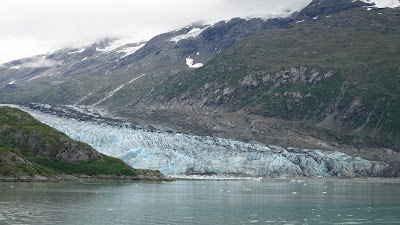Friday, August 11th.
Woke up to pea soup this morning. I couldn’t see anything, but my chamberman assured me that it is always foggy going to Glacier Bay National Park, but it always clears when the ship gets there. Turns out he was right. This is a long bay carved out by glaciers years ago, but there are still several flowing down from the mountains to the sea. The water contains pieces of floating ice called growlers or burg-bits, which are pieces that float about three metres above the water and can damage smaller vessels. Icebergs are much bigger and must be about sixteen metres above the surface. The ship stayed in the bay for about an hour so that we might see some calving (where pieces of the glacier breakaway – but we didn’t) and to give us a chance to see some wildlife, again, we didn’t. The sun actually came out for a bit too. While we were viewing a ranger was giving us information about the mountains and the glaciers and he emphasized that all of Alaska’s glaciers are in retreat because of climate change and that Alaska has seen a three-degree temperature change in the last couple of decades while the lower states have risen less than a degree. The captain turned the ship seemingly on a dime so that both sides of the ship could see the glaciers. In addition, the doors were open for the first time so that we could get out onto the bow for even better viewing. It was quite cool out and I had to wear a hoodie and down jacket and light gloves in order to stay outside for a while. Then we sailed back out of the bay and continued up the coast to the beautiful Margerie Glacier with it’s glistening white/blue face at the ocean’s edge. In the afternoon I went to the World Stage to hear one of the park rangers give a presentation about the history of Glacier Bay. Captain George Vancouver was the first to see this bay and described it as ‘a sheet of ice as far as the eye could distinguish.’ The famous naturalist Joh Muir visited in 1879 and it was the result of his writing and promotion of the area that tourists began to come here on steamer ships in the late 1800’s. It was also because of him that the US declared it a national monument and later a national park. After dinner I had a beer in one of the small pubs sitting by the window and reading my Kindle about the Erebus. Then I went to the World Stage and watched the dance group that I saw the other night. Tonight, they performed a different show called ‘Humanity’ and again it was sensational. Both shows amazed me by the amount of practise required to nail the dances and sync with the stunning graphics projected onto the screen behind them. It was a truly interactive show and I loved it. I went for a walk on the Promenade deck on level three which circles the entire ship. It was milder out this evening than it was this morning. There was no one out there and it was great to hear the wind and water as the ship sailed through the waves. Back to the room by 11. Captain made an announcement this evening that we are expecting a big storm overnight with high winds and seas of 15ft!
Other than the beauty of the area scientists
are interested in Glacier Bay because of the rapid change that has happened
here. This from the internet:
“Enter Glacier Bay and you cruise along shorelines completely covered by ice just 250 years ago. Explorer Capt. George Vancouver found Icy Strait choked with ice in 1794, and Glacier Bay was a barely indented glacier. That glacier was more than 4,000 feet thick, up to 20 miles or more wide, and extended more than 100 miles to the St. Elias Range of mountains. But by 1879 naturalist John Muir found that the ice had retreated 48 miles up the bay. By 1916 the Grand Pacific Glacier headed Tarr Inlet 65 miles from Glacier Bay's mouth. Such rapid retreat is known nowhere else. Scientists have documented it, hoping to learn how glacial activity relates to climate changes.”










Very informative post, Joe. Stark and rugged scenery to match.
ReplyDeleteBeautiful scenery! So did you get the big storm??
ReplyDelete